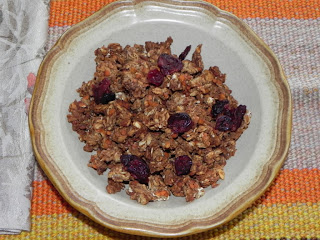 The thing I like about Monster Cookies are that they basically work with what you probably already have in your kitchen -- peanut butter, sugar, oats, butter (or in my case, vegan butter or coconut oil or even just canola oil), eggs (ehm, fake eggs), and chocolate, nuts/seeds, and dried fruit. Or, whatever else you want to throw in them.
The thing I like about Monster Cookies are that they basically work with what you probably already have in your kitchen -- peanut butter, sugar, oats, butter (or in my case, vegan butter or coconut oil or even just canola oil), eggs (ehm, fake eggs), and chocolate, nuts/seeds, and dried fruit. Or, whatever else you want to throw in them.I haven't made them since switching to a vegan diet, though I have made vegan monster cookies before. And I haven't tried to consciously make them just a little better for you, while still definitely tasting like an indulgence. To be sure, these are cookies, and they are an indulgence, just so we're all clear. But some indulgences are worse than others, right??
What makes these monster cookies better for you? Well... that's a somewhat subjective question, but these cookies are:
- Gluten-free
- Vegan
- Low in refined sugar (they use agave nectar and the pictured cookies also use Enjoy Life (vegan, gf, soy free) semi-sweet chocolate chunks
- High protein (especially if you add seeds/nuts!)
Monster Cookies (vegan, gluten-free)
1 cup creamy peanut butter
1/2 cup agave nectar
1 tablespoon coconut oil, melted
2 flaxseed eggs (2 tablespoons ground flaxseed combined with 6 tablespoons water)
1/4 cup unsweetened apple sauce
2 1/2 cups gluten-free oats (quick oats works best, but I never have them on hand, so pictured you'll see old-fashioned oats)
1 teaspoon baking soda
1/4 teaspoon salt
1.5 cups of any combination of the following (or whatever your heart desires): VGF chocolate chunks/chips, sunflower seeds, pumpkin seeds, dried cranberries, raisins, chopped peanuts, VGF candy-coated chocolate (i.e. - sunspire drops), coconut flakes, slivered almonds, banana chips, etc.
Preheat oven to 350 degrees. In a medium-sized mixing bowl, combine the peanut butter, agave nectar, coconut oil, flax eggs, and apple sauce, and stir until well mixed. Add the oaths, baking soda, salt, and fruit/nut/chocolate combo. Stir well.
Allow the dough to rest for 20-30 minutes (especially important if you're using old-fashioned oats, because this allows them to become a little softer). Scoop the dough, by 1/4 cupfuls onto a baking sheet that has been lightly greased, or lined with parchment. Cook 12-15 minutes and allow to cool another 3-5 minutes on the cookie sheet, before trying to remove them.
Serve, or allow to cool completely and store in an airtight container for 3-5 days.
NOTE: You can also make smaller cookies (say 2 tablespoons, 1/8 cup). If you opt for this, keep an eye on them while they cook and reduce cooking time to 10-12 minutes. They should be golden brown around the edges when they are ready.






























